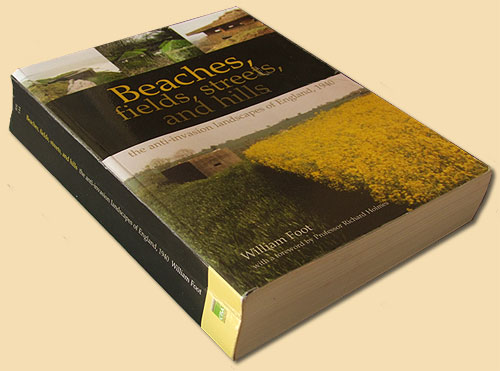Beaches, fields, streets and hills
Posted: 23 October 2006 11:58
Having had a nasty virus over the weekend, something that has helped speed my recovery was the delivery of Beaches, fields, streets and hills: the anti-invasion landscapes of England, 1940 by William Foot. (CBA Research Report No.144, Council for British Archaeology 2006; ISBN 1 902771 53 2).

This volume of over 600 pages details the findings of the Defence Areas Project, looking at 67 localities specially selected on account of the surviving defences within them and the supporting documentary evidence.
Written by the former manager of the Defence of Britain Project, the result is an amazing work containing detailed descriptions of each area, including photographs, maps and aerial photographs. Each area is classified according to whether it is an example of Coastal Defence, Stop Line Defence or Area Defence.
A few areas of particular interest to me are explained in depth; the Royal Military Canal, Cuckmere Haven and Pevensey Castle (I visited the latter a week ago, but haven't had time to write up a blog on it yet!).
In a small way, this is disappointing for me, as I was conducting my own research into these areas; had I acquired this book when it was first published (back in June, I think), I might have saved a lot of time. I don't regret the work I put in, however, as it was highly satisfying, even though I now find my research was replicating a small part of what had already been done.
Research overlap is inevitable, particularly in a subject that has seen a huge increase in popularity in recent years. One thing that is gratifying though, is the fact that my TNA document list for Cuckmere Haven and Pevensey Castle is almost identical to Foot's, so at least my research technique is pretty sound.
Foot also includes a Place Name Index to 1940/41 Defence Schemes and Operation Instructions, linking them with their associated TNA reference. I cannot overstate how important this index is, as it provides a quick way to find documents that have hitherto been hidden amongst the numerous pages of unit war diaries with no form of indexing or reference.
The Place Name Index alone shows the staggering level of research that has gone into this book, and it is easily worth the �25 cover price. (I'd say it was worth it just for the three chapters I've read so far!)
I'll put the index to work on my next archive visit.
- Pete

Email:
Blog Latest

Bishopstone reveals its pillbox secrets
18 October 2021

Pillbox or Observation Post?
10 June 2020

Uncovering the hidden secrets of a pillbox
8 June 2019

Review of 2018
31 December 2018

Wartime Christmas in East Sussex (2)
24 December 2018
Jargon-buster
Defence Areas Project
A study based on 67 areas identified from the Defence of Britain Project database as good examples of areas where significant portions the defences still survived, the study of which resulted in William Foot's Beaches, fields, streets and hills.
Defence of Britain Project
A large project run by the Council for British Archaeology (CBA) 1995-2002, collecting data on 20th century military structures submitted by a team of some 600 volunteers. The result was a database of nearly 20,000 records which is available online. The anti-invasion section of the database contains nearly 500 entries for East Sussex.
Defence scheme
A military plan of defence for a specified area. Defence Schemes were issued at numerous levels. Defence Schemes were later known as Plans to Defeat Invasion on the orders of General Montgomery.
Stop line
A physical continuous anti-tank barrier, normally a river and/or railway line, often defended by pillboxes. Stop line crossings (roads, railways and bridges) were to be made impassable.
TNA
The National Archives (formerly The Public Records Office or PRO).
This site is copyright © Peter Hibbs 2006 - 2024. All rights reserved.
Hibbs, Peter Beaches, fields, streets and hills (2024) Available at: http://pillbox.org.uk/blog/216510/ Accessed: 27 July 2024
The information on this website is intended solely to describe the ongoing research activity of The Defence of East Sussex Project; it is not comprehensive or properly presented. It is therefore NOT suitable as a basis for producing derivative works or surveys!